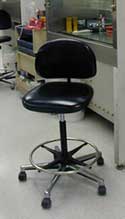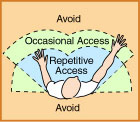Hospitals eTool
Pharmacy » Work-related Musculoskeletal Disorders


Hazard
Pharmacists and pharmacy technicians are exposed to ergonomic-related risk factors, such as repetitive movements, forceful exertions, awkward postures or contact stress, while performing tasks such as opening/closing bottle lids, or using a computer. Exposure to ergonomic hazards may lead to musculoskeletal disorders (MSDs) including carpel tunnel syndrome, tendonitis, or tenosynovitis.
Recognized Controls and Work Practices
- Use assistive devices, if available, to eliminate the need to do tasks manually, (e.g., use devices designed to open bottle lids for pharmacist).
- Provide supportive comfortable chairs that include foot rests and ensure that there is knee clearance under the desk.
- Redesign processes to incorporate variation into tasks (e.g., alternate repetitive tasks with those that do not require high repetition).
- Provide anti-fatigue mats or lean stools when the job requires standing on hard surfaces.
- Look at the workstation layout and:
- Arrange materials and supplies in front of the body so they can be easily reached with the elbows in close to the torso.
- Provide adjustable, supportive padded chairs that support the forearms, legs, and low back. Arm rests need to allow the elbows to hang normally at the side of the body.
- Arrange monitors so that the most commonly viewed area is slightly (about 20 degrees) below horizontal eye level and can be seen without looking up, or leaning forward.
- Provide engineering controls to limit awkward positions, (e.g., provide head-sets for employees to use when answering phones).
- Use a keyboard, which includes an adjustable mouse support that can be easily reached from a keying position. Employees need to keep wrists straight while typing and use wrist pads to rest on when not typing.
Additional Information
- Computer Workstations. OSHA eTool. Can help identify, analyze and control musculoskeletal disorders associated with computer workstation tasks.
- Computer-Related Eye Strain: How Pharmacists Can Protect Their Vision. Pharmacy Times, (April 11, 2014).
- Ergonomics. OSHA Safety and Health Topics Page.
- Inspection Guidance for Inpatient Healthcare Settings. (June 25, 2015). OSHA memorandum establishing guidance for inspections conducted in inpatient healthcare settings.
- Also see Hospital-wide Hazards - Work-related Musculoskeletal Disorders.

